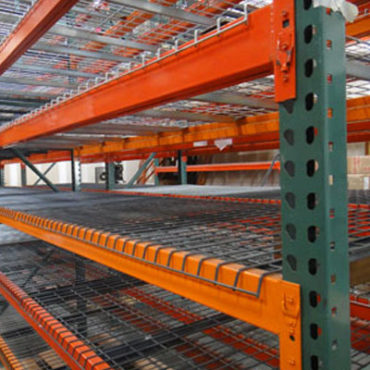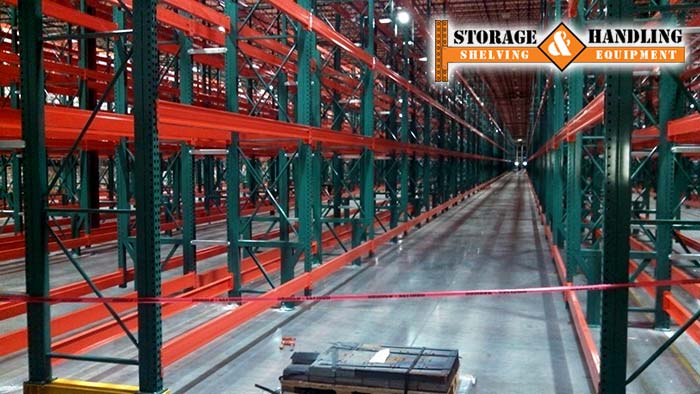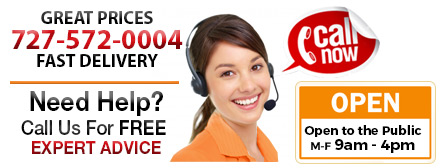
Tips to Make Sure your Pallet Rack is Safe
- Pallet Racking Florida
- May 2, 2018
Don’t let this be a scene in your warehouse!
The Majority of Pallet Rack Fails are from:
Misuse and Overloading
Impact from Fork Trucks
Not understanding and/or respecting how dangerous pallet rack can be if some of these tips aren’t followed. Just because it’s heavy duty and looks sturdy, doesn’t mean it can’t come crashing down.
#1 Know the Capacity of your Pallet Rack and Post it for All to See
If you’re buying new rack, they usually come with labels that state the rack’s capacity. If you’re buying used rack they may no longer be there so make your own labels and post. The main thing is you don’t exceed the listed capacity. Sounds like a no-brainer but you need to enforce your capacity ratings so that your racks will not be overloaded or misloaded. Take the Home Depot incident in Santa Clarita, CA. When an earthquake hit, it was only the pallet rack overloaded with ceramic tile that collapsed. As a result, over 160 Home Depot stores were retrofitted with heavier, higher capacity racks in their ceramic tile areas. The cost of the retrofit is estimated to be approximately $15 million (see p. 23/2.5.2) By posting capacities on the racks, it’s clear at a glance how much weight the beams can take. Beam capacity is much easier to understand than upright capacity. The rule of thumb is that the greater the vertical space between beam shelves, the lower the upright capacity. When purchasing new pallet rack shelving, check the weight of your heaviest products and items against the capacity of the uprights and beams you intend to store them on. This simple, quick step could save someone’s life.
#2 Use Protection
If you have constant forklift and picker traffic, post protectors & upright protectors are a must. They’re easily applied to the bottom of the post and to the ground, providing stability for your shelving while protecting it from potential damage. The corners and ends of the rack aisles are most susceptible to a direct fork truck hit – so defend them. Utilize steel guardrails, (placed 1’ – 3′ in front of the rack), post protectors and other means to shield them from fork truck accidents.
Protectors applied to some heavy duty shelving
#3 Fix It Down
Anchors, tie plates & row spacers are ideal for tall shelving and long shelving runs. By anchoring your heavy duty shelving to the floor or wall, you’re significantly reducing the risk of it falling over. There’s not much worse than a shelving system collapsing, destroying your valuable stock and items. We strongly recommend you consider purchasing anchors, tie plates and row spacers with new shelving systems. We’d also recommend assessing the need to anchor your existing system.
#4 Use Wire Decks
Wire decks are a great way to improve health and safety in your warehouse or storeroom. They’re able to catch inventory and debris falling from higher shelves, plus there’s no dust build up. If there’s a fire and your sprinkler system goes on, the water can get to where it needs to go.
#5 Inspect
Make it a part of your routine to inspect frequently, at least monthly. While a quick visual inspection won’t tell you anything other than a rack may have been hit, that’s the start of getting it repaired to safe standards. Less frequently, an independent engineer should inspect your rack. When you inspect, look for (1) Damaged uprights; (2) Damaged or bent beams; (3) Operational and capacity signs; (4) Overloaded beams – are they bent or deflected beneath the load; (5) Is the rack plumb and vertical?; (6) Look for missing beam clips or other connections; (7) Damaged welds; (8) Beams popped out of the uprights; (9) Damaged braces or column protectors.
Have a no-repercussions policy for reporting impacts. Guys make mistakes – even good drivers. During a fast paced day, they may smack an upright. You need to know that it happened, so don’t punish them for reporting it. Sometimes, the damage can be slight and the driver will decide it’s in his self- interest to let it slide, even though a quick visual inspection can confirm whether or not the accident has possibly damaged the structural integrity or capacity rating. Let your drivers and warehousemen know up front that you want to know, and that they won’t be reprimanded if they tell you.
#6 Maintain Frequently
Replace damaged racks. This is another no-brainer. Yes, it is a pain to unload racks, take them down and put in new uprights or beams, but it’s for the sake of your inventory and the forklift drivers or pickers who are working beneath these racks. If something is damaged, and it’s carrying thousands of pounds of product, it can trigger collapse in entire rows, endangering people and costing much more than individual replacements.
#7 Don’t Alter Rack without Professional Assistance
Don’t allow cleats or other items to be welded to beams, uprights, bracings, etc, or for its load profile to radically change. If you do make appropriate, engineer-approved changes, change your facility drawings, signage and processes to denote what was done. Rack accidents are also caused by improper installation & maintenance. If your uprights are not properly bolted to the floor, or have loosened over the years, rack accidents can occur. Check them regularly to be sure. Boltless beams should always be secured to the rack. Check the rivets after installation to be sure they fit snugly and that safety clips are utilized. Monitor them over time to be sure they haven’t been knocked out of place.
#8 Loading and Unloading Properly
Place the load squarely. Drivers should be trained to deposit pallets correctly on the rack beams. They should be square, and if possible should overlap uniformly on the front and back. This helps you maintain evenly-distributed loads, which are vital to maximizing rack capacity and saving wear on your beams. Also, pallets out of square can cause accidents in 2-deep rows when the other side is being loaded. Placing the load only onto wire decks, where the pallet isn’t supported by rack beams, can greatly reduce capacity. Don’t stack items directly on top of each other if they aren’t designed for this. Instead, place it directly and evenly onto the shelf.
#9 Guard your Rack Bays with Netting or Wire Guards
These safeguards are relatively inexpensive solutions, and can be invaluable in particular in areas where there is foot traffic, order picking, or other human activities in the aisles below. See pallet rack safety netting or wire rack guard panels for more information.
seismic zone
#10 Know your Seismic Zone Situation
In areas where racks should be modified for seismic issues, it’s vital to understand what local, state or federal seismic regulations you must adhere to. This tends to involve larger footplates and specialized installation methods, but may not necessarily be limited to that.
This entry was posted in Uncategorized and tagged OSHA pallet rack rules, OSHA pallet rack safety, pallet rack beams clearwater, pallet rack clearwater, pallet rack installation, pallet rack lakeland, pallet rack largo, pallet rack mesh panels clearwater, pallet rack pinellas county, pallet rack pinellas park, pallet rack protectors, pallet rack safety, pallet rack st. petersburg, pallet rack tampa, pallet rack uprights, used pallet rack clearwater, used pallet rack tampa, wire deck surfaces clearwater. Bookmark the permalink.
← 8 Reasons Why You May Need an In-Plant Office
How to Get Organized This Year →
Recent Posts
Wesco Industrial Products Compares their Pallet Jacks to their Competitors
Time to Plan Spring Cleaning….of Your Warehouse
Material Handling Netting Prevents Hazardous Falls
How to Get Organized This Year
Tips to Make Sure your Pallet Rack is Safe
Proud to Serve:
Tampa, St Petersburg, Clearwater, Lakeland, Tarpon Springs, New Port Richey, Safety Harbor, Dunedin, Oldsmar, Bradenton, Palmetto, Sarasota, Plant City, Winter Haven, Bartow and all of Florida including Pinellas, Hillsborough, Pasco, Polk, Sarasota and Manatee Counties.
Leave Your Comment Here
You must be logged in to post a comment.

